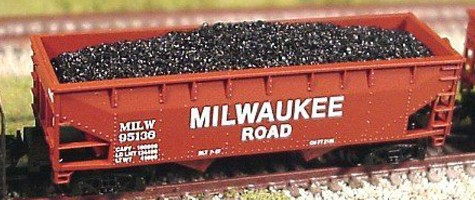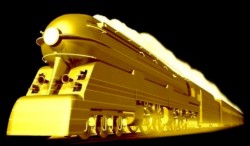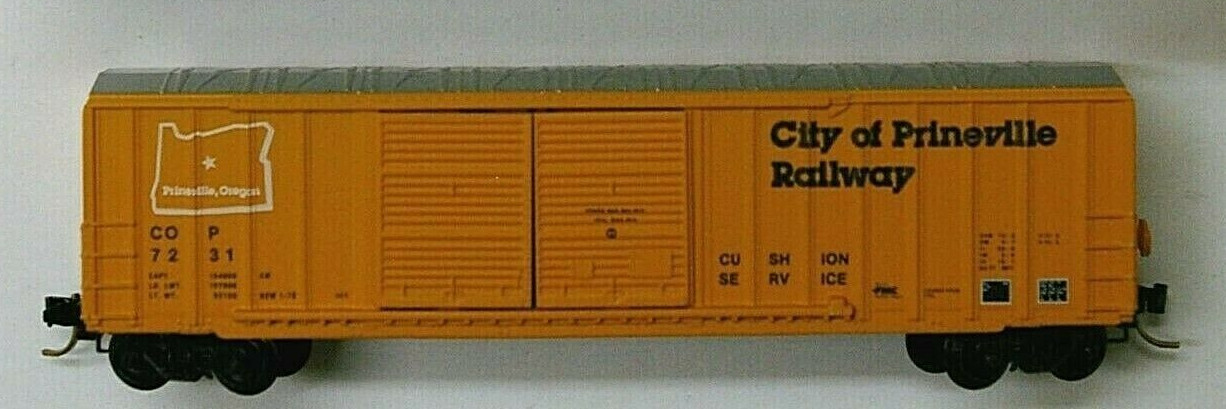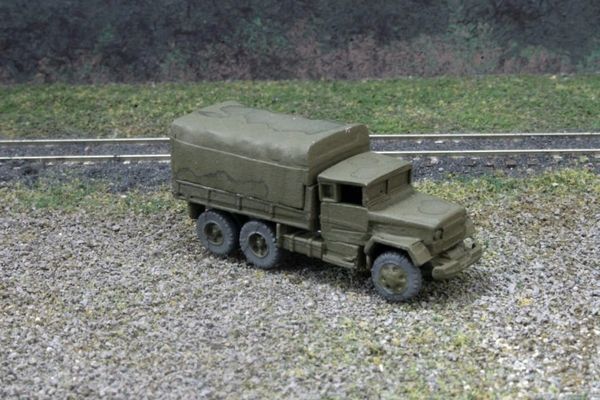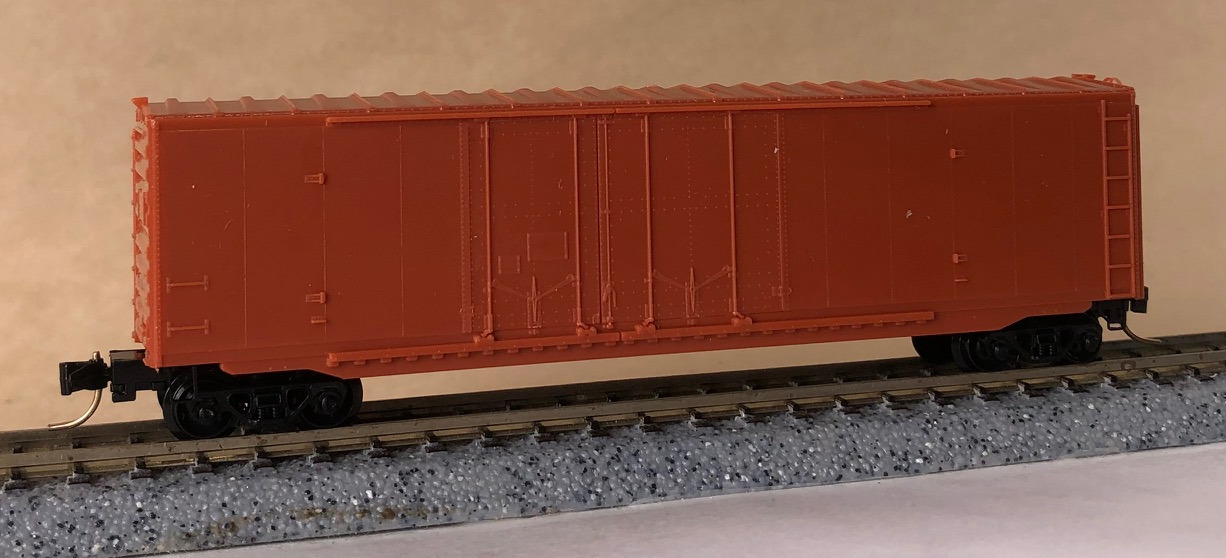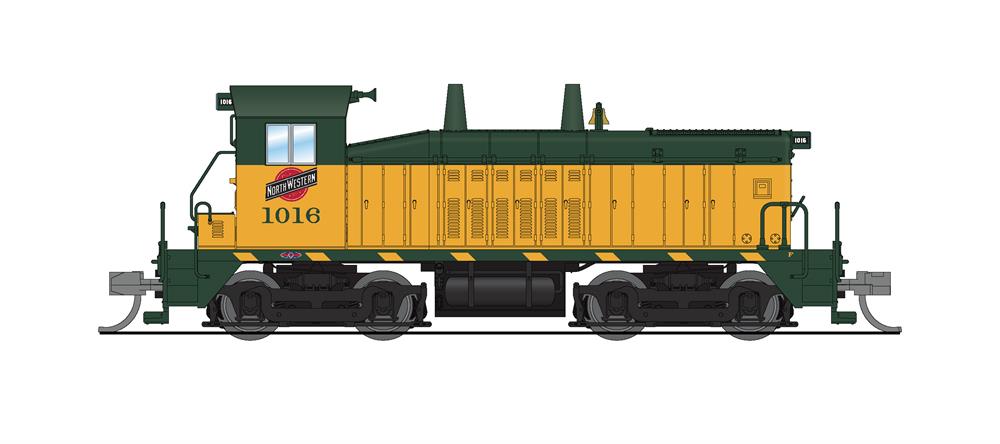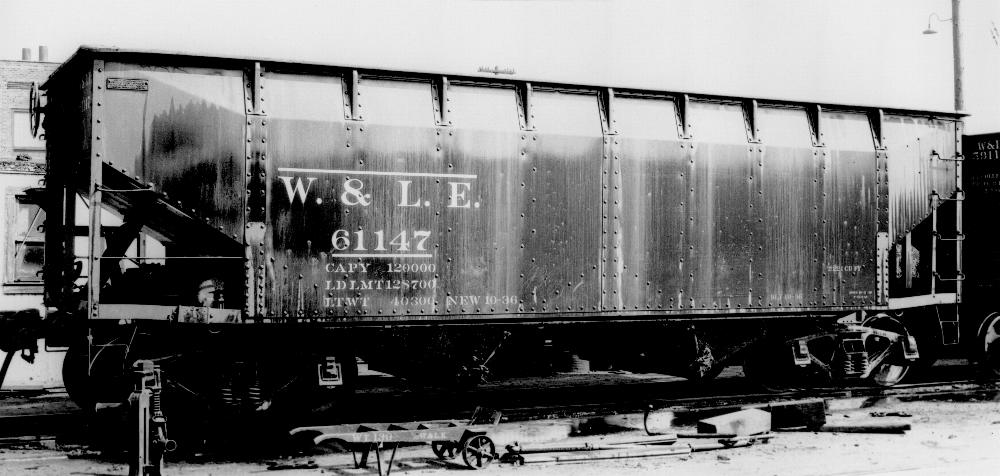Specific Item Information: Road Numbers: MILW 95101 & 95124
Model Information: During the first half of the 20th Century, the most common carrier for the transport of coal via rail lines was, in fact, the pervasive little 50-55 ton, twin-bay hopper. Ever-inventive engineers designed a different style of this essential hauler which became enormously popular with many Railroads by the 1930s and 40s. This "offset-side" hopper car had a few advantages over the earlier "rib-side" type. The crease in the upper sides led to more structural strength without using heavier materials, and there was a greater rated capacity with the side panels riveted to the outside of the ribbing, instead of being on the inside. The efficiency was a boon to the coal merchants! The concept proved successful, and was used to build ever-larger hoppers until after WW II, when "rivet pull-through" rendered it impractical for modern rotary dumping. Today, although they are seen less frequently, offset-side hoppers remain an important part of railroad history. Full Throttle presents a universal model of these unique hoppers.
Prototype History: The late 1920s saw the introduction of the AAR standard “offset-side” 50- and 70-ton hoppers. The design went through several variations in the late 1920s and early 1930s before settling on two versions of the 50-ton car and one 3-bay, 70-ton car in 1935. Most roads went for the AAR standard designs, but the N&W, VGN, and Pennsy were notable holdouts. World War II brought the famous “war emergency” hoppers (only the N&W and MP bought the 70-ton version) and several composite versions of existing designs. After the war, AC&F found some brief success with a welded outside-stake hopper design, but the weld joints broke under the stress of loading and unloading rather than flexing like riveted joints. The offset-side design also had problems: the inside stakes were more prone to corrosion, and they suffered worse from loading and unloading stress than outside-staked hoppers. The design waned in the 1950s and was all but abandoned for new cars by 1960. Some roads (notably the C&O, the B&O, and the L&N) made the best of a bad situation by rebuilding their offset-side cars with all new outside-staked sides in the late 1950s and early 1960s.
Road Name History: 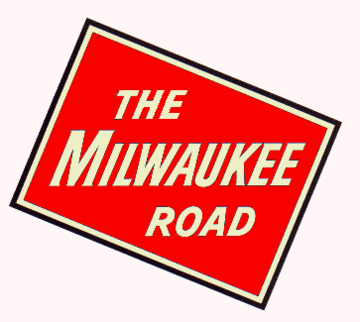 First of all, Milwaukee Road has only ever been a popular nickname. The real name from 1874 was Chicago Milwaukee & St. Paul. For the next 36 years, the CM&StP linked Chicago with Milwaukee, Green Bay, Madison, Wausau, the Twin Cities, Duluth, Kansas City and Omaha with a dense network of branches in Wisconsin, Iowa, southern Minnesota and eastern South Dakota. Essentially, the lines ended at the Missouri River.
First of all, Milwaukee Road has only ever been a popular nickname. The real name from 1874 was Chicago Milwaukee & St. Paul. For the next 36 years, the CM&StP linked Chicago with Milwaukee, Green Bay, Madison, Wausau, the Twin Cities, Duluth, Kansas City and Omaha with a dense network of branches in Wisconsin, Iowa, southern Minnesota and eastern South Dakota. Essentially, the lines ended at the Missouri River.
With a dearth of friendly western connections, CM&StP decided to build their own line to the Pacific. The original target was the bustling megalopolis of Eureka, California. However, they built toward Seattle instead. In 1909 the line opened. Along the way, they served Miles City, Lewiston, Great Falls, Harlowton and Butte, Montana; Avery, Idaho; and Spokane, Seattle and Tacoma, Washington. In 1912, they began to electrify two long segments, Harlowton, Montana to Avery, Idaho and Othello, Washington to Tacoma.
In 1921, they leased the Chicago Terre Haute & Southeastern and a bit later the Chicago Milwaukee & Gary to reach the coal fields of southern Indiana. Both roads were in trouble and dragged the CM&StP into receivership. In 1928, they emerged with a small name change. It was now the Chicago Milwaukee St. Paul & Pacific. Right after that, the nickname “Milwaukee Road” began to catch on.
The three Class One’s that already served the Pacific Northwest, Northern Pacific, Great Northern (along with their jointly owned minion Spokane Portland & Seattle) and Union Pacific were not pleased with their new neighbor and avoided building interchanges with them unless absolutely necessary. This left Milwaukee to haul whatever traffic they could originate or terminate on their own line or via a hand full of shortlines with which they interchanged. This is why when you see photos of Milwaukee Road trains west of the Dakotas, an exceptionally large majority of cars are lettered for Milwaukee Road.
Milwaukee’s steam fleet is generally quite handsome beginning with the period after WWI. Many locomotives were built in their own shops. The steam era came to an end on the Milwaukee in 1957.
The electrified lines were ruled by boxcabs and Bi-Polars for decades. In the 1950’s, Little Joe’s diverted from the Soviet Union arrived on the Milwaukee (and the South Shore.) By the late 60’s diesels began to regularly invade the electrified lines. Little Joes and diesels were MU’ed. The aging catenary could only handle so many electrics at a time so diesels filled the horsepower gap. By 1972, falling traffic, a declining fleet of serviceable electrics and the deteriorating catenary caused Milwaukee Road to de-energize the western lines lines with Avery to Harlowton lines following two years later.
Meanwhile on the east end, as a condition of the 1971 merger of Monon into L&N, Milwaukee Road received trackage rights from Chicago to Louisville. This gave Southern a friendly connection to Chicago it was losing with Monon.
In 1977, Milwaukee Road entered receivership again. This time, radical restructuring was needed. In 1980, everything west of Miles City, Montana was abandoned. Some lines were picked up by connections or spawned new shortlines but nearly 1,000 miles of track was pulled up. In 1982, Miles City to Ortonville, Minnesota was abandoned. Milwaukee was concentrating on their pre-1909 routes plus the new line to Louisville.
In an attempt to win back middle distance TOFC traffic, Milwaukee began running fast and short piggyback trains, usually behind a single SD40-2 and with a dozen or so 89’ flats. Unit coal trains added to the bottom line. By the mid-80s, the streamlined Milwaukee Road was up for sale and Grand Trunk Western, Chicago & North Western and Soo Line got into a bidding war. GTW had diverted 40,000 cars onto Milwaukee Road between Chicago and Duluth to help them turn a profit in 1983. Ironically, the ICC (which controlled mergers at the time) pushed GTW out of the contest leaving just C&NW and Soo. Furious, GTW diverted their 40,000 carloads off the Milwaukee. C&NW outbid Soo, but the ICC chose Soo Line anyway. Milwaukee Road merged into Soo Line in 1985. Almost immediately, Soo shops began painting big black rectangles over MILWAUKEE ROAD on the diesels, giving birth to the “bandit” paint scheme.

With a dearth of friendly western connections, CM&StP decided to build their own line to the Pacific. The original target was the bustling megalopolis of Eureka, California. However, they built toward Seattle instead. In 1909 the line opened. Along the way, they served Miles City, Lewiston, Great Falls, Harlowton and Butte, Montana; Avery, Idaho; and Spokane, Seattle and Tacoma, Washington. In 1912, they began to electrify two long segments, Harlowton, Montana to Avery, Idaho and Othello, Washington to Tacoma.
In 1921, they leased the Chicago Terre Haute & Southeastern and a bit later the Chicago Milwaukee & Gary to reach the coal fields of southern Indiana. Both roads were in trouble and dragged the CM&StP into receivership. In 1928, they emerged with a small name change. It was now the Chicago Milwaukee St. Paul & Pacific. Right after that, the nickname “Milwaukee Road” began to catch on.
The three Class One’s that already served the Pacific Northwest, Northern Pacific, Great Northern (along with their jointly owned minion Spokane Portland & Seattle) and Union Pacific were not pleased with their new neighbor and avoided building interchanges with them unless absolutely necessary. This left Milwaukee to haul whatever traffic they could originate or terminate on their own line or via a hand full of shortlines with which they interchanged. This is why when you see photos of Milwaukee Road trains west of the Dakotas, an exceptionally large majority of cars are lettered for Milwaukee Road.
Milwaukee’s steam fleet is generally quite handsome beginning with the period after WWI. Many locomotives were built in their own shops. The steam era came to an end on the Milwaukee in 1957.
The electrified lines were ruled by boxcabs and Bi-Polars for decades. In the 1950’s, Little Joe’s diverted from the Soviet Union arrived on the Milwaukee (and the South Shore.) By the late 60’s diesels began to regularly invade the electrified lines. Little Joes and diesels were MU’ed. The aging catenary could only handle so many electrics at a time so diesels filled the horsepower gap. By 1972, falling traffic, a declining fleet of serviceable electrics and the deteriorating catenary caused Milwaukee Road to de-energize the western lines lines with Avery to Harlowton lines following two years later.
Meanwhile on the east end, as a condition of the 1971 merger of Monon into L&N, Milwaukee Road received trackage rights from Chicago to Louisville. This gave Southern a friendly connection to Chicago it was losing with Monon.
In 1977, Milwaukee Road entered receivership again. This time, radical restructuring was needed. In 1980, everything west of Miles City, Montana was abandoned. Some lines were picked up by connections or spawned new shortlines but nearly 1,000 miles of track was pulled up. In 1982, Miles City to Ortonville, Minnesota was abandoned. Milwaukee was concentrating on their pre-1909 routes plus the new line to Louisville.
In an attempt to win back middle distance TOFC traffic, Milwaukee began running fast and short piggyback trains, usually behind a single SD40-2 and with a dozen or so 89’ flats. Unit coal trains added to the bottom line. By the mid-80s, the streamlined Milwaukee Road was up for sale and Grand Trunk Western, Chicago & North Western and Soo Line got into a bidding war. GTW had diverted 40,000 cars onto Milwaukee Road between Chicago and Duluth to help them turn a profit in 1983. Ironically, the ICC (which controlled mergers at the time) pushed GTW out of the contest leaving just C&NW and Soo. Furious, GTW diverted their 40,000 carloads off the Milwaukee. C&NW outbid Soo, but the ICC chose Soo Line anyway. Milwaukee Road merged into Soo Line in 1985. Almost immediately, Soo shops began painting big black rectangles over MILWAUKEE ROAD on the diesels, giving birth to the “bandit” paint scheme.
Brand/Importer Information: Greetings, I'm Will, a Fine Arts graduate of Kutztown University in Pennsylvania who grew up in the Delaware Valley. I worked for 30 years with the Pennsylvania German Folklife Society. For ten years I had a permanent booth, each month showing my "PA Dutch" wares, at the country's largest under-roof Antique Market in Atlanta, GA. When Mom and Dad started to have health issues, I was forced to give up the nomadic life, but during my travels I came to love Z Scale Model Railroading, as I could easily take small layouts with me to the motels and play with my trains in the evenings!
Now that Mom and Dad are gone, and after many years of providing care for my "Pappy" in Florida, I find myself a homebody in the "Sunshine State" with a neat little business, supplying interested Z hobbyists with rolling stock and unique quality products!
Item created by: CNW400 on 2021-08-25 09:34:47
If you see errors or missing data in this entry, please feel free to log in and edit it. Anyone with a Gmail account can log in instantly.
If you see errors or missing data in this entry, please feel free to log in and edit it. Anyone with a Gmail account can log in instantly.


